

This page consists explanations to many words, not all mentionad within this site, but of which all relates to the topic above - runes. If you by any chance can't find what you are looking for, please feel free to email us, and we will do our very best to try to help you out.
Alliteration
Anglo-Saxon
The Anglo-Saxon runes were used foremost in Great Britain from the 600's and to the Medieval Age.
Bracteat
Bridge
Bronze Age
Clandestine runes
The dark blue clandestine runes in the middle are called ice-runes - the first staffs tell to which ätt the rune belong - the last staff which number in the ätt the rune has.
At last there is a runic chiffer - which is when a rune is told by its prior or coming rune.
Dalerunes
Danish runes
The picture to the left shows a part of a page from the Icelandic
Drottning
Endrune
Eril
Ferrule
Futhark
Galdir
Gardarike
"Give the eagle food"
Grave-mead
Hälsingerunes
Hög
Iron Age
Kenning
The picture to the left is a Swedish pendant of a woman, these findings and other drawings give us a sense of what clothes they wore. You can see the fibula on her shoulder, and the big perls hanging down her chest, for a drawing of it, see fibula.
Kummel
Keip
Medieval Age
Normal runes
Norröna / Norrøna / Norrœna - Old Norse
If you are interested in this, our ancestral mother-tongue, take a look at Rob's Old Norse page!
A rime of letters or verses. Not really a rime, but similarity in the beginning of words. The alliterated letters shall be stressed. The consonants are often used for alliteration (welling water's winsome word - wind in warm wan weather) and should be the same letter, but vowels are better if not similar.
Alliteration is most known from the ancient Nordic poetry, especially from the Poetic Edda and from some runic stones. The alliteration-poetry have been "adopted" by many other languages, like the British example above, by Swinburne. Other English poets like Shakespeare, Shelley and Tennyson liked to use alliteration too.
When the Huns devesteted Europe from the 400's and forward for some hundred years, big groups of people started to move and settle new ground. Among them were the Anglish and the Saxon people, who originally lived in present Germany and present Denmark. These two people were both from the Germanic descent.
When the Huns reached their territory, they took their homes and familys and sailed over the sea to new land, and this new land is today known as Great Britian. They fought the Celtic people living here since the beginning of time and settled down on this big island. They were soon known as one people - the Anglo-Saxons, as they developed the same language and writing system.
The border between present England and present Wales was once drawn by King Offa in the 700's to seperate the the Celtic speaking and the Germanic speaking people of Great Britain.
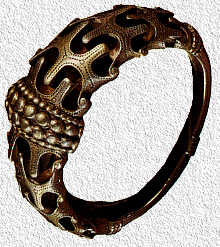 We do not have a clear picture of what went on the first 200 years after the invasion of Anlish and Saxon people, but big chiefs with names like Hengist, Horsa, Vortigern and Arthur survived in the Sagas to these days. But what can we say about reality?
We do not have a clear picture of what went on the first 200 years after the invasion of Anlish and Saxon people, but big chiefs with names like Hengist, Horsa, Vortigern and Arthur survived in the Sagas to these days. But what can we say about reality?
We do know that handicraft had an important role insociety. We know how Kings lived, they had big halls and storing houses, they had a stronghold, a burial ground and a hall of council. They often had a church too.
England's Christianizing startd in the year 597 AD when Saint Augustinus arrived.
Like in Scandinavia and many other places in Europe, every little province had his own King, and all these places in England once had an own King:
Northumbria, Mercia, Kent and Wessex. The English Kingdom and unition took place first in the 900's.
This piece of jewellery looks like a medal and is a pendant of gold, and was used in Scandinavia during the time of the Big Migration
Around 500 different bracteats have been found, and one third of these have a runic inscription on them.
Bridges are often mentioned on Christian runic stones, and sometimes also talked about as a bridge for the soul, and here is one possible reason:
These stones are always raised next to water of some kind, to mark a fordable place in for example a river.
Not a bridge in that sentance but a place where it was OK to wade over. To raise such a stone took time and knowledge, and why would people raise bridge stones for others? I mean, they already knew where to wade...
Maybe because it was a good action, and many good actions led to Heaven after death. Maybe that is why they are called a bridge for the soul - because it was a way for the raiser/carver to assure his way/bridge for his soul to heaven?
The time from 1800 BC to 500 BC.
These are of different kind and in different systems. There are two especially popular systems of clandestine runes, both based on the fuþarks order.
The fuþark is divided into three groups, called the three ätts. Below is a picture of the original fuþark with its three ätts - called:
They have their different names depending on which rune that starts the group, in this case the F-, the H- and the T-rune.
To make this system even more complicated - the first and the last ätt got to change number, that is why the first ätt has number 3 instead of number 1.

In this system shown above, there is a main-staff and several bi-staffs in the clandestine runes.
The bi-staffs to the left shows to which ätt the rune belong and the staffs to the right tells which place in that ätt the rune has, an example:
-The p-rune (2:6) is the sixth rune in the second ätt.
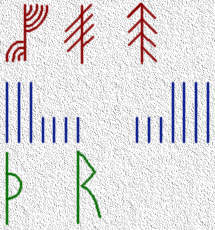 Here are some exampels of other clandestine runes, all of them picturing the letter A from the original fuþark. The clandestine runes at the top, in dark red are all called staff-runes.
Here are some exampels of other clandestine runes, all of them picturing the letter A from the original fuþark. The clandestine runes at the top, in dark red are all called staff-runes.
These could also be fishes on which one should count the fins at the back and the chest to get the right rune, or faces where one shall count the beard-straws pointing to the left and to the right. They sure had imagination!
The name for the last runes used in Sweden, from Dalarna.
The old name for the normal runes and the normal fuþark, with 16 runes, which originated from Denmark.
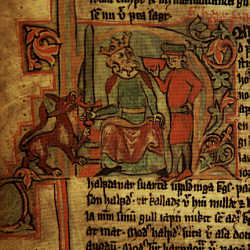 Drott
Drott
The old Nordic word for King. It is funny that is was changed into its present form: Kung when Drottning - right beneath, didn't change.
Both the old and the present name for a Queen.
The last rune in a word. Compare to Oddrune.
I am just guessing here, couldn't find an explanation anywhere, but an Eril seems to be the title of a rune carver, like the name of the proffesion,a s it surely was, side by side with agriculture.
A little mounting of metal, which is placed in the end of a sword sheath, to prevent the sword's edge to cut through the leather in the sheath.
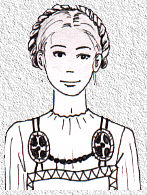
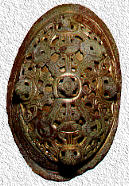 Fibula
Fibula
A cloth-buckle, with a safety pin construction, but no feather. It looked a bit like a turtle shell in its shape. The women used them to keep their aprons up.
The women had two fibulas each, which were worn on the shoulders, as the picture to the right shows, and they often had like a necklace (OF DARK PERLS IN THE PICTURE) which connected the fibulas.
Keys, scissors and other female-accoceries were worn in tiny chains from the fibulas, hanging down their dresses, sometimes down to the knees.
The fibulas could be in different metals, the wealthy women had gold, highly decorated.
The runic alphabet, named after its six first runes (LETTERS) : F U Þ A R K
![]()
![]()
![]()
![]()
![]()
![]()
![]()
![]()
![]()
![]()
![]()
![]()
![]()
![]()
![]()
![]()
![]()
![]()
![]()
![]()
![]()
![]()
![]()
![]()
An sort of ancient Nordic singing - to protect oneself from evil spirits and other dark powers.
The Viking name for present Russia.
This expression is a kenning for killing. It is a poetic circumscribing of how the birds of preys nourished of the corpses on the battle-fields, a true Viking on mission were suppossed to leave such after himself in great numbers.
;-)
This was a feast the old Northmen held for their beloved ones whence they had died. It was custom to arrange a grave-ale for a dead man, the richer - the bigger feast. The people sort of celebrated his memory with food and lots of mead, a kind of old Nordic beer/ale/stout. The word for beer in today's Nordic languages is: öl or spelled øl. The word used on runic stones is: ALU or AUL or similar. The English word most similar to this is of course ale.
Older name for the staveless runes, because the first examples of these were found in Hälsingland, Sweden.
This Nordic word means both "high" and "barrow".
The time from 500 BC to 1050 AD, it is normally diveded into the following periods:

This is a circumscribing of something, the most famous English kenning would be SHIP OF THE DESERT for a camel. The Kennings used in old Nordic poetry often requires a quite big knowledge about the Æsir cult and all it consists, if you want to understand all of them, some examples:
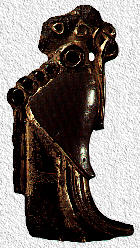 Kona
Kona
Old Nordic word for "wife" - today called Fru, after the godess Freya - also called Housefru - or Housefreya, Fru was one of her bi-names.
Swedish word for barrow and/or cairn. The dead people had a KUMMEL raised to their memory be their family. It could be a pile of stones, but the word could also symbolize just a grave, it could mean a runic stone or some other "eye-catching" stone-monument as a memory.
An old Nordic word for an ancient kind of Scandianvian oarlock.
For Scandinavia, from the year of the Christening until the Reformation, when Catholicism were traded to Protestantism with Martin Luther.
For Sweden: 1050 AD to 1525 AD.
The name for the fuþark consisting of 16 runes, the original fuþark had 24 and it was reduced in the 800's - the beginning of the Viking Age. At the same time, the original language, Old Norse - split up in each country and started to develope into todays different Scandianvian languages.
As all languages consist of 40 sounds - as did the Nordic tongue, some runes represented more than one sound.
These runes are the most common ones, and almost every one of Sweden's 2500 runic stones are carved with these.
In English referred to as Old Norse - the Original Nordic Language, or the Runic Tongue.
This was the anscestral language to all Scandinavian languages we talk today, and very similar to present Icelandic, both in words, grammar and melody. The different languages splitted up in the 800's - the beginning of the Viking Age and then developed fast into what they are today.
Old Norse is tightly connected to both Old English and High German, all of these three languages are now considered dead.
We know that the whole of Scandinavia had only one language, almost unchanged from place to place, which we can base upon the runic texts and other sources, found all over the Nordic countries.
He will explain it further and he is in charge of this Old Norse webring:
|
|
|
|
|
|
|
|
|
|
||||
Oddrune
The first rune in a word. In a runiform ornament, the oddrune isn't always written down - if it is suppossed to be the same as the former word's endrune.
Old Norse
Read above on Norröna.
Preroman Iron Age
Quick
Roman Iron Age
Runebomme
Runic Almanac
Sailing horse
Samestave-runes
Samish
They are a very peaceful and mysterious people, they are actually one of the few peoples on this earth who have never run a war. They live in peace together with the nature, and have no need for more than they need. Their minds and culture is very far from ours - and it is really great. Just imagine what the world would look like if all people thought as they did...
Seyd
Short hand runes
Sigrdrifomál
Skald
Smoke runes
Staveless runes
Stung runes
Stuprune
Stuped turned rune
Swedish-Norweigan runes
Särkland
Tegn
Teuton
Thing
Time of the Big Migration
Thul
Translitteration
Turned rune
Turs/-ir
Valdemar-runes
Vendel Age
Viking Age
Älvdalen
Äring
Ätt
The word ätt is an ancient Nordic word for family /dynasty.
Ättebacke
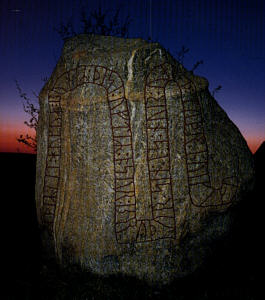 Paint
Paint
Runes were first carved, and then painted, most often in red. Unfortunately, none of these colours have survived into our days, and that is a true pity - as some of the runic stones most certainly were very beautiful and painted in many colours.
A national team of people travel around Sweden every tenth year to re-paint the runes with red, to save them and keep them readable for the future.
It was sometimes one man who carved the runes into the stones, and another one who painted them. Sometimes a third name is mentioned - he who hew the stone to the right shape and size, made a side flat and maybe made a nice form of it.
The time from 500 BC to 0, a part of the Iron Age.
An old word for "alive", the present Swedish spelling is kvick and both words origins from the Old Norse word K U I K U A N.
The time from 0 to 400 AD, a part of the Iron Age.
The Old Norse and Norweigan word for the Samish peoples' drum.
An almanac in which the days of the year and special holidays are all marked with runes. It is an "eternity-almanac" - it can be used any year.
The seven days of the week are marked with the following runes:
F U Þ A R K H - which is for Monday to Sunday, and repeated 52 times.
The Golden numbers(THE NUMBER WHICH TELLS WHICH YEAR IT IS; BASED ON THE 19 YEARS-CYCLE OF THE MOON) are also used for telling when the Easter arrives, are written with all the 16 runes in the fuþark, beneath the runes for every day, and in addition three extra runes.
The Runic Almanacs have been found both written on pergament and paper, and also carved into wood, bone or horn.
The oldest found Runic Almanacs are from the 1200's - but are most often younger, like the 1600's.
The picture below shows a part from a runic almanac, this part is the two months Mars and April.
It shall be read from the right to the left:
The characters which stick up marks holidays, the first mark is on Mars 7 - PERPETUA, next comes a branch without leaves - GREGORIUS on Mars 12 (Now the trees will start to get their leaves back after the winter). The next mark is the little shed on Mars 17, thehouse symbolizes a chapell, the Saint sign of GERTRUD. The snake is awaking from it's wintersleep soon after, at BENEDICTUS Mars 21. LADY ANNUNCIATION DAY is at Mars 25, the beginning of the Spring season. This special day is marked by a crown in shape of three branches.
The following mark is April 4 - AMBROSIUS, and then another branch at April 14 - TIBURTIUS - when the Summer season starts. The next mark is GEORGE, April 23 and the last in this picture is a bird, symbolizing that the cuckoo arrives at MARCUS, April 25.

A kenning for a ship.
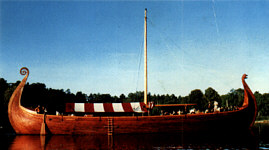
This is when several runes are placed on the same main-staff.
As it (of course) would be hard to see the I-rune, it is almost always placed besides the main-staff.
![]()
This people are sometimes called the Indians of Scandinavia, and are a nomadic people, living in the northern parts of Scandinavia, in the fiells, where they keep raindeers for a living. As with all original populations, their rights are small today in the western society. Their grounds are "stolen" by the Gouvernment and their culture is slowly more and more affected by the Swedish living and modern equipment, like snow scooters, computers and such.
They do not consider themselves as neither Swedish, Norweigan or Finnish, no matter which language they know and where they live - they are all Samish and move around the without caring about the borders.
The Samish have their own language and their speciality is to yodel.
The most interesting with them from scientistic view is that their genes are so totally unique that no one can really tell where they origins from..
It is like they have always been there...
This a kind of Black Magic - which is used in the North to bring misfortune on a person.
The name of a simplified version of the normal fuþark consisting of 16 runes. This type of runes were easier and faster to carve down and were probably used a lot by the people when writing. Their appaerence compared to the normal runes are that their bi-staffs are shorter.
One of the 19 Heroic songs in the Poetic Edda, it is Icelandic and means The song of Sigdrifa.
This is an old Nordic word for a poet who makes songs. Often like the Eddaic poetry and poems/songs.
The old name for the short hand runes.
The name of an even more simplified version of the normal fuþark consisting of 16 runes. This type of runes were very easy and fast to carve down and were used for short notes and such, nothing of higher importance.
These runes totally lacks the main-staff and consists only of a bi-staff.
When Christianity came and with it the Latin alphabet, the high and important people insociety wanted to adapt the fuþark to the A B C-order, so a new fuþark came - the stung one!
The 16 runes in the normal fuþark was used, and in addition ten of them vey doubled and equiped with dots, to represent a different sound - totally 26 runes (LETTERS) and sounds.
A rune which is upside-down in comparison to the other runes.
A rune which is upside-down and also reversed in comparison to the other runes.
An older name for the short hand runes.
The Viking name for present Iraq.
A free man. On Danish runic stones, this word is sometimes used together with the similar word drengR, which means farm hand.
A suggestion is that tegn would mean "oldest son" which would be the man to inherit the farm and that drengr would mean "younger sons".
Sometimes, the word is better translated with "oath-sworn warrior".
An old word for people of Germanic descent, which is the people today living in present Germany, the United Kingdom, the Neatherlands and Scandinavia.
An old word for a council, where laws were set and important subjects discussed. Iceland had a big meeting every year, called the Allthing. There could also be small things held when needed, like when a crime had been commited or something of major importance had to be solved. At the thing, a judge was present, and he judged in all, together with some vouches, which were men everybody believed in and trusted.
The time from 400 AD to 550 AD, a part of the Iron Age.
The title thulr are used on Danish runic stones, and in western Nordic poetry, it is sometimes translated with "speaker", "poet" or "singer". The word has obviously to do with verbal recitation.
This is when every rune is translated literally, and then we get a sence of what the language sounded like.
A reversed rune, in comparison to other runes.
A Turs is another name for a Giant - an older name in the North.
An older word for the younger medieval runes, especially the runes which are formed in the order of a Latin alphabet.
It was King Valdemar who put the runic fuþark in the Latin way, says Olav Thordsson Whitepoet in the year 1250.
The time from 550 AD to 800 AD, a part of the Iron Age. The Vendel Age was named after a grave-yard from this time filled with ships, found at Vendel's church in Uppland, Sweden.
The time from 800 AD to 1050 AD, when Sweden was Christianized. The Viking Age is the last part of the Iron Age.
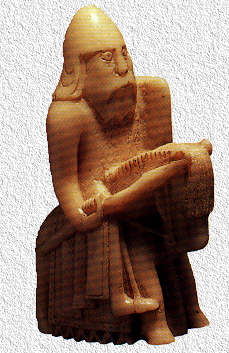 Vouch
Vouch
A vouch is a man who could vouch for other men, as he had earned every man's trust. He was honest and good and had a great respect. The vouches were present a the big Allthing which was held every year, and where big questions were discussed and solved.
There were many vouches, and they kind of acted like a jury. You were a lucky man if you had a friend who was a vouch - then you had his support if you were in trouble.
The Älv(RIVER) dale/valley. This is a place in Sweden - the last place in this world where the runes were known and used by the people until the year 1900 at least...
This was what the Northmen did, it was to sacrifice to the Æsir (GODS) of fertility - to ensure a good harvest that year, probably the äring was held in the spring-time.
![]()
The fuþark is divided into three groups, called the three ätts. Below is a picture of the original fuþark with its three ätts - called:
They have their different names depending on which rune that starts the group, in this case the F-, the H- and the T-rune.
To make this system even more complicated - the first and the last ätt got to change number, that is why the first ätt has number 3 instead of number 1.

The ätts were important for the useage of clandestine runes, a kind of coded text.
In the system shown above, there is a main-staff and several bi-staffs in a clandestine rune.
The bi-staffs to the left shows to which ätt the rune belong and the staffs to the right tells which place in that ätt the rune has, an example:
-The p-rune (2:6) is the sixth rune in the second ätt.
The word could most easily be translated with "familyhill" and were the place were the Nordic people buried their deads, before Christianity arrived and along with it the churches and cementaries.
© Copyright 1998-1999 - OÞALA http://www.geocities.com/Heartland/Village/7780 othala@email.com